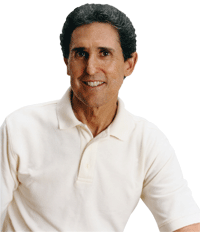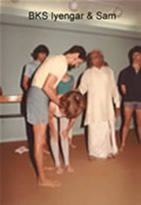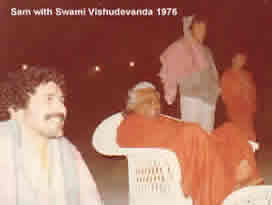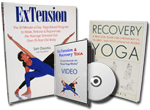
Our Biography
Sam began studying yoga in 1975 and by 1977, he was teaching it
full-time. Sam was an early student of BKS Iyengar and after many trips to India, was senior-certified by him in 1985. Through the years, Sam has both studied and taught yoga throughout North America, Europe, and India.
Lauri has studied dance and body movement since childhood and began studying yoga many years ago after experiencing a knee injury that left her with chronic pain. Lauri's quiet perception of the needs of others along with her deep compassion for all living things, has created a teaching environment that has brought a feminine sensitivity and an increased dimension to Sam's teaching.
 ABOUT SAM:
ABOUT SAM:
If you were to watch my advanced morning yoga practice and especially the broad array of students I teach, from the most advanced to the most profoundly injured and ill, you would never suspect I am chronically ill myself; that I experience bouts of debilitating chronic fatigue, and that I am still recovering from the paralysis of both arms and shoulders that began in 1996.
Even though I can once again do some advanced yoga postures, I'm unable to do most of what I could do before the onset of my illness ... which doesn't bother me in the least. However, let me start from the beginning.
I began practicing yoga more than thirty years ago and in those days, other than BKS Iyengar, most yoga taught in the West was “classically influenced” by the various Swamis who came from India during the 1950's and 60's (see History of Yoga).
I soon became mesmerized by yoga’s effect upon my body and mind; and in my quest to better understand its mechanics and adaptations for Westerners living in a Western culture, I began to seriously study anatomy, physiology, and kinesiology.
I was a long-time pupil of BKS Iyengar who certified me as an Intermediate-Senior Iyengar Yoga Teacher in 1985; but in my ongoing quest to better understand yoga, I also studied with many other yoga teachers and masters throughout North America, Europe, and India.
I then studied NeuroMuscular Therapy so I could integrate that understanding into my yoga practice and teaching; and eventually, I also became a licensed and certified NeuroMuscular Therapist.


By the early to mid 1990’s, there were many yoga books on the market, but few explained the actual mechanics of yoga; of how yoga works. Instead, most were “follow the pictures” or “do as I do” kind of programs and unless you were as naturally flexible as were the people in the pictures, you risked injury and the harder you tried, the more you were at risk.
Unfortunately, large numbers of people trying to learn from yoga books were quitting. Many dropped out because they felt they weren't flexible enough or because they felt that yoga was just too hard. Many quit because of overly sore muscles or in worse case scenarios, because they became injured ... all in their quest to follow the pictures and their limited written instructions. Age also had a lot to do with the number of drop-outs.
Basically, the younger and more flexible you were, the easier you could do what was shown in the books; but still, many dropped out because it was too hard. Generally, if you were past your mid-thirties or if you were stiff, injured or chronically ill, doing yoga from books was much harder if not impossible. I wanted to write something substantially different so that anyone regardless of strength, flexibility, or age could successfully practice yoga.
After nearly 20 years as a full-time yoga instructor teaching throughout North America and abroad, my first book was finally published, ultimately in several languages. Published by Simon and Schuster, ExTension Yoga is a Western approach to yoga that explains how and why yoga should be adapted for varying body types and levels of flexibility, strength, and endurance.
ExTension Yoga is a program appropriate for all normally healthy people, from couch potatoes to athletes. But soon after its publication, the direction of my life and my yoga changed forever, and those changes motivated me to eventually write a second book.
The very same concepts and techniques I presented in ExTension Yoga became the foundation for my second book published two years later by Random House; but it was not to be an advanced program that continued on from where ExTension Yoga left off. After years of practice and teaching, the latent beast that my yoga had suppressed from my youth finally re-emerged: My body relented to multiple sclerosis.
In the first year or two after I became ill, as the disease began to ravage my body, I could no longer do my regular ExTension Yoga practice. That's when I conceptualized and wrote Recovery Yoga. Not knowing how severely ill I was still to become, I developed a program that embraced the very same logic and mechanics as ExTension Yoga, but was modified so that chronically ill and injured people could use yoga as a tool to help deal with chronic illness or injury.
As my illness continued to progress, I felt as if my yoga had failed me. I eventually became clinically depressed and for over a year, I quit yoga altogether. After gaining nearly 20 pounds and feeling my life was over, Joyce, a former student of mine and an incomplete quadriplegic, came to visit.
Some 18 months earlier as I was nearing the end of my yoga practice, I taught Joyce the logic and foundations of Recovery Yoga. She took what I taught her seriously and even though I had subsequently quit yoga, Joyce continued to practice. Coming to visit, she wanted to share with me how significantly yoga had affected her life.
There she sat, an incomplete quadriplegic, telling me how much better she feels from the yoga I taught her ... and there I sat, a quitter feeling sorry for myself and what I had lost.
As a result of that meeting and because of my embarrassment, I renewed my yoga practice the next morning. Using the very book I wrote as my guide and starting on page one, I began practicing Recovery Yoga ... and the rest as they say, is history.
It took me about nine months to do everything in the Recovery Yoga program. I then picked up my first book, ExTension Yoga, and began practicing that from page one. It took me about another nine months to be able to do everything in ExTension Yoga.
Today, I sometimes am able to go well beyond both programs approaching the advanced practice I had before I became ill. On the other hand, some days I might only do Recovery Yoga and some days, I might only do ExTension Yoga. I no longer care because I no longer try to do yoga. Instead, I have finally learned how to do yoga. That's what this e-book is all about.
I've learned that the basic foundations of both Recovery Yoga and ExTension Yoga are exactly the same and that they apply as equally to chronically ill and injured people, as they do to highly trained athletes ... and to everyone in between.
That's the beauty of this approach to yoga and it is what I practice and teach: It's not based upon trying, but instead it's based upon the quality of what you can do without forcing that maximizes its benefits and minimizes its liability. By applying the logic and principles of ExTension and Recovery Yoga, flexibility, strength, and endurance no longer become the goal of yoga; but instead, become merely the result of an appropriate practice ... at whatever level is attainable.
It doesn't matter if you are a beginner or an advanced yoga practitioner; it doesn't matter if you are "just a yoga student" or if you have been teaching yoga forever; it doesn't matter if you are perfectly healthy or if you are injured or ill; and it doesn't matter if you are young or old, because the first time you come to study with me, I will show you how the logic and techniques of this system will apply to your body.
The first time you take a class with me, I will compare how flexible and well-balanced you think you are with how flexible and well-balanced you really are. Make no mistake about it: Based upon the experience of just about everyone who has come here, the differences from where you think you are to where you really are ... are usually dramatic.
The Counter-Intuitive Nature of this Work:
The material presented in the program and in this e-book will appear at first to be counter-intuitive to what you've previously learned about yoga and even with exercise in general. However, the more you read this material and apply its logic and principles to your own personal practice and to your teaching, the more you will appreciate how effective it is.
I invite you to read this entire online book that examines the mechanics of yoga. Because I actively seek questions and feedback, I invite you to return often as I am constantly refining and adding additional content.
Brief excerpts containing a few of the actual yoga routines from ExTension and Recovery Yoga can be found on the menu which is on the right side each page. Both of my books and my video lecture are available for purchase at the bottom of every page. Enjoy!
 Return to top
Return to top

